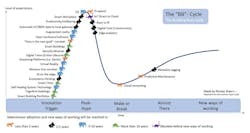We need to better understand the power, the potential and the speed at which we can achieve the necessary change by bringing digital natives—and the digitally enhanced and augmented—into our workforces to help solve our present education emergency.
Our planned education sessions 2020 Vision for Automated Buildings AHR Expo speaks well to today's metamorphic change.
Building automation is fast becoming another IT/Cloud/Data-driven industry. As it evolves towards deeper digitization, our industry is fast becoming a new playground for the hyper-digital who are ready to take buildings to the next level. The hard part? How do we redefine our business models as we try to recruit, train and retain this next group of all-stars?
Propagating our People Power is our ongoing challenge. To grow our industry younger, we need to get out the message that we are an exciting industry where young folks can make a difference. We need to offer them Job Crafting—allowing employees to design their own jobs—and promote job flexibility to attract them. The same factors that attract folks go a long way to keeping them engaged and passionate while helping us hold on to them longer. We need to tell our stories, share our passion, and invite people to participate.
Becoming IP-Enabled: People and Products
Much like Internet Protocol-Enabled devices, IP-enabled people are forcing the improvement of the occupant experience by matching the building to the technology they are using. People are becoming a a new subset of the IoT movement. To survive, we need both our people and products to become IP-Enabled. We all need to stand firm on our roots while learning what our new IP-Enabled world looks like. We Digital Immigrants need to merge with younger folks, the Digital Natives, to continue our IoT journey.
We need to practice what we preach while painting a vivid picture of our new purpose and what we are selling as our core services to attract and retain the new generations.
Here’s an article from Memoori.com that makes some great points:
“The Office has to be Interesting, or Else People are Just Going to Work from Home”
“The tremendous value organizations place on their people extends to real estate, as executives realize that giving people a job and a place to work is not enough—you need to create a space where they want to be. Human experience is a key differentiator for how people engage with an organisation — both strategically and operationally,” JLL explains in the context of retaining talent from the tech-savvy emerging millennial workforce.
Millennials will make up 75% of the workforce by 2025, and Generation Z (born since the year 2000) began to enter the workforce from 2018. These are generations that have grown up with digital and connected technology, and they will prioritize smartly designed and technology-rich workplaces when choosing between employment options. Driven by the desire to attract the best young talent, tenants will increasingly choose smart buildings for their physical workplaces or consider more remote and virtual options that are also popular with younger workers.
Smart office adapts to people’s needs
The office as an active contributor to business success. By 2030, millennials are expected to make up 75% of the workforce – and they are demanding a more productive and flexible work environment that enables activity-based working.
Smart offices are the key to meeting these requirements. They use state-of-the-art building technology to improve employee performance and reveal ways to use office space efficiently and economically.
By providing the ideal conditions for the task at hand, By giving the people a voice in deciding how and when spaces are used, By creating communities.
Here’s a fun article by our contributing editor Nicolas Waern that explores the “Hype Cycle” of our education emergency:
Building Buzz Breakdown – Innovation all around, Metadata tagging, Cloud computing, Digital Twins, IoT, wireless, smart buildings, 5G, augmented reality, virtual reality, predictive maintenance and a partridge in a pear tree. It’s a jungle out there, which is why I tried to jot down some of the things I’ve seen lately and put them in the Building Buzz-cycle depicted below. The perspective is that from a more traditional building automation perspective, and that’s why it might differ to other frameworks. However, everything in the BB-Cycle is doable today, quite easily if you know what you are doing. But it will take time to reach mainstream adoption, if ever, and there’s no time like the present.
I go into a deeper discussion of the Education Emergency on the latest episode of ControlTalk NOW:
ControlTalk NOW Interview previews BAS Industry’s “Education Emergency” — Ken Sinclair tells all in his August AB Edition "The amount we need to learn and the speed at which we need to learn it is unprecedented." Ken Sinclair, Founder, Owner, Publisher AutomatedBuildings.com Get your insight to Ken Sinclair’s August edition of Automated Buildings. The road ahead is challenging all right, but mighty favorable, especially when you’re willing to re-calibrate to a 2020 vision.
Here are a few resources to aid us in attracting digital natives while fueling their and ability to change our industry:
The Book - Digital Transformation Survive and Thrive in an Era of Mass Extinction by Thomas M. Siebel:
“Urgent doesn’t begin to describe the insights contained in Tom Siebel’s Digital Transformation.” — Eric Schmidt Former CEO of Google Inc.
Discontinuity, Driven by Disruption, Is the Rule Evolutionary development is marked by isolated episodes of rapid speciation between long periods of little or no change.
Mass Extinction, Mass Diversification When science and technology meet social and economic systems, you tend to see something like punctuated equilibrium. Something that has been stable for a long period suddenly disrupts radically— and then finds a new stability.
"Introduction to the IOT" Coursebook by iot-open.eu, a European Community project under the Erasmus+ education program:
The IoT Coursebook has pretty broad content, suitable for readers that want to start their experience with embedded systems, networking and Internet of Things. Over 300 pages
The clear organisation of Introduction to the IoT Coursebook helps you to choose interesting chapters, so you do not necessarily need to read it from cover to cover. Just benefit from the selected sections like IoT networking, IoT Data, IoT hardware and software development for the Internet of Things.
IoT technology stack – from IoT devices, sensors, actuators and gateways to IoT platforms. By i-scoop.eu, a Belgium-based educational resources organization:
A look at IoT technology and the first layers of the IoT technology stack: IoT devices (including sensors and actuators), IoT gateways (and device management) and IoT platforms.
Table of Contents
What is IoT technology? The IoT technology stack
IoT devices and connected physical things
IoT devices: sensors
IoT devices: actuators
IoT gateways: devices on the intersection of devices/data and IoT platforms
IoT technology beyond the gateway: IoT platforms
SENSING TINY THINGS Do you understand how fast the world is changing? from Harbor Research.
One indication of the speed is the fact that we’re drowning in unprocessed information. We’re creating data at 2X the rate we’re deploying traditional bandwidth to carry it, but almost all the data created to date has never been analyzed.
More than half the data created by physical or operational systems loses any value that could be derived through analysis in less than a single second.
Yet by 2020, according to the National Science Foundation, there will be trillions of sensors on the earth. And forecasters predict that in just a few more years there will be more processing power in smart phones than in all the servers and storage devices in data centers on the earth today. Ready or not, we’re rushing into the future of truly distributed systems and intelligence.
We need to depict our industry as the exciting new playground it is, a place for the hyper-digital to take our buildings to the next level. We need to show them the excitement of creating the killer User Experience, and the difference it can make in the wider world. Just how can we do that?
This interview, The New Kidd on the Block is between me and Lucy Kidd, a Data Scientist with BUENO Systems who is helping our industry grow younger and smarter with machine learning. It seems like a good way to close this chapter in our ongoing story:
Sinclair: How did you start working within the Smart Buildings industry?
Kidd: I was a fresh Graduate that was mainly interested in robotics and AI when I came across an online ad for a Data Scientist at BUENO. It seemed like a great application of programmatic knowledge to the real world, while also being socially conscious.
Sinclair: What does BUENO do and why are you passionate about it?
Kidd: BUENO designs and builds leading edge technology that enables Data Driven Engineering services within the built environment. We believe in the best possible performance and efficiency of our built environment. By continuously developing the highest quality analytics platform for building systems, we reduce costs and environmental impact, streamline workflows, increase transparency, visibility and potential of a building’s performance and efficiency.
We apply data science over operational technology dataset to automate diagnostic tasks and fuel optimisation of a variety of building systems.
Working with BUENO has been super rewarding for me, not only do I consider everyone in my office kind of like family, but I get to hear about some incredible energy-saving results that clients have achieved using software that I have contributed to. Hearing these good news stories, paired with the challenge of solving complex problems, is what makes me passionate about the work that I do
About the Author
Ken Sinclair
Editor/Owner/Founder
Ken Sinclair has been called an oracle of the digital age. He sees himself more as a storyteller and hopes the stories he tells will be a catalyst for the IoT future we are all (eventually) going to live. The more than 50 chapters in that ongoing story of digital transformation below are peppered with HTML links to articles containing an amazing and diverse amount of information.
Ken believes that systems will be smarter, self-learning, edgy, innovative, and sophisticated, and to create, manage and re-invent those systems the industry needs to grow our most important resource, our younger people, by reaching out to them with messages about how vibrant, vital and rewarding working in this industry can be.

